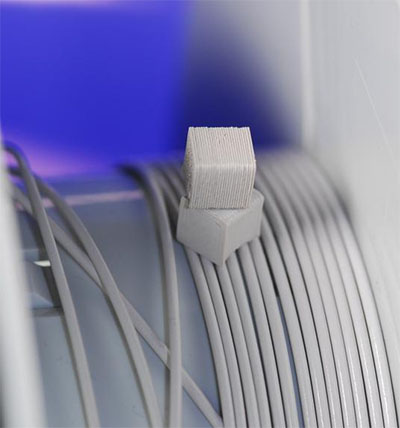| Jan 26, 2022 |
Disinfected with light: self-cleaning surfaces protect against the transmission of bacteria and viruses
(Nanowerk News) In times of high risk of infection, effective protective measures are needed. Avoiding transmission routes via contaminated surfaces is an important part. It is known that photocatalytically active coatings reduce the microbial load. In order to increase the efficiency of this light-driven reaction, a novel active composition was developed and introduced into materials within the "Covid-DEKONT" project.
|
|
By combining copper-doped titanium dioxide with layered silicates, a synergistic effect was observed that brings pathogenic bacteria and viruses more effectively into contact with the catalysts and accelerates their inactivation.
|
 |
| Copper-doped catalyst in layered silicates composite into filaments for the Fused Filament Fabrication (FFF) 3D printing process. (Image: Fraunhofer IFAM)
|
|
In order to contain the currently rampant COVID-19 pandemic, active disinfection of frequently touched objects such as door handles, stair railings, tables, or shopping carts is already part of our daily routine, in addition to numerous other protective measures. Without disinfection, the period of time that viruses can survive without a host cell depends on many boundary conditions.
|
|
Above all, ambient temperature, air humidity, UV radiation as well as the material composition and surface properties have a significant influence. It is therefore a complex interaction of numerous external factors.
|
|
The aim of the research work carried out by Fraunhofer IFAM in cooperation with the University of Szeged in Hungary was to develop a flexible coating solution for component surfaces for this purpose, which enables reliable and permanent decontamination without chemical treatment and which can also be implemented cost-effectively on a large scale.
|
Layered silicates enable direct contact with microorganisms
|
|
Initial development work by Fraunhofer IFAM on silver-doped titanium dioxide photocatalysts intercalated in layered silicate and dispersed in a polyurethane coating – PU in short – has shown that application of the functional coating on surfaces enables successful decontamination of bacteria as well as viruses – even in the visible light range at wavelengths > 430 nm.
|
|
One decisive cause for this fast and effective mechanism are the layered silicates themselves, which form active centers of a few nanometers in size on the surface, thus enabling direct contact between the microorganisms and the photoactive substances. This development has already been patented (DE 10 2012 219 918 B4).
|
|
In a further approach, silver has been substituted by copper and was produced using a scalable manufacturing approach. In the light of the ongoing COVID-19 pandemic, the effectiveness should be tested not only against bacteria, but also against viruses. For good reasons, strict safety regulations exist for laboratory work with microorganisms. Therefore, model microorganisms were used which, due to their structure, have an environmental stability and disinfectability, that are comparable, but not human pathogenic.
|
Copper replaces expensive silver and shows high efficacy against viruses on both metallic and polymer surfaces
|
|
The fact that silver-doped photocatalysts can be used for the aforementioned application has been described extensively in scientific literature. However, various studies point out that the use of nanosilver also poses risks for living organisms and the environment. For example, nanosilver can enter the body through skin and is therefore controversial. In addition, the high price of the precious metal is another reason for looking for alternatives and developing a safe and cost-effective coating for industrial use.
|
|
For the production of the copper-doped photocatalyst, a process was developed at Fraunhofer IFAM which also allows the production of larger quantities already on a laboratory scale. The catalyst could then be dispersed in a PU coating system and also compounded in thermoplastic polymers. The thermoplastic polymers could be easily extruded into filaments, which could then be printed into complex components using the 3D printing process Fused Filament Fabrication (FFF). The influence of different filling contents of the photocatalyst complex on their antimicrobial effectiveness was investigated.
|
|
The test series showed that fill levels of the photocatalyst complex of around 35 percent by weight in the PU coating and 50 percent by weight in the polymer achieved very good antibacterial and antiviral degradation results. Within two hours, a degradation rate of more than 80 percent could be achieved compared to the control components, both under UV light and with a light source similar to sunlight.
|
|
As a result, silver can be fully replaced by copper in the various applications. A patent application has also been filed for this process.
|

